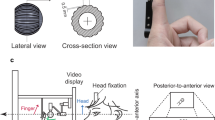Abstract
The primary sense modalities (vision, touch and so on) are generally thought of as distinct. However, visual imagery is implicated in the normal tactile perception of some object properties, such as orientation1, shape and size2. Furthermore, certain tactile tasks, such as discrimination of grating orientation1 and object recognition3, are associated with activity in areas of visual cortex. Here we show that disrupting function of the occipital cortex using focal transcranial magnetic stimulation (TMS) interferes with the tactile discrimination of grating orientation. The specificity of this effect is illustrated by its time course and spatial restriction over the scalp, and by the failure of occipital TMS to affect either detection of an electrical stimulus applied to the fingerpad or tactile discrimination of grating texture. In contrast, TMS over the somatosensory cortex blocked discrimination of grating texture as well as orientation. We also report that, during tactile discrimination of grating orientation, an evoked potential is recorded over posterior scalp regions with a latency corresponding to the peak of the TMS interference effect (about 180 ms). The findings indicate that visual cortex is closely involved in tactile discrimination of orientation. To our knowledge, this is the first demonstration that visual cortical processing is necessary for normal tactile perception.
This is a preview of subscription content, access via your institution
Access options
Subscribe to this journal
Receive 51 print issues and online access
$199.00 per year
only $3.90 per issue
Buy this article
- Purchase on Springer Link
- Instant access to full article PDF
Prices may be subject to local taxes which are calculated during checkout




Similar content being viewed by others
References
Sathian,K., Zangaladze,A., Hoffman,J. M. & Grafton,S. T. Feeling with the mind's eye. NeuroReport 8, 3877–3881 (1997).
Klatzky,R. L., Lederman,S. & Reed,C. There's more to touch than meets the eye: the salience of object attributes for haptics with and without vision. J. Exp. Psychol. Gen. 116, 356–369 (1987).
Deibert,E., Kraut,M., Kremen,S. & Hart,J. Neural pathways in tactile object recognition. Neurology 52, 1413–1417 (1999).
Sadato,N. et al. Activation of the primary visual cortex by Braille reading in blind subjects. Nature 380, 526–528 (1996).
Cohen,L. G. et al. Functional relevance of cross-modal plasticity in blind humans. Nature 389, 180–183 (1997).
Sadato,N. et al. Neural networks for Braille reading by the blind. Brain 121, 1213–1229 (1998).
Büchel,C., Price,C., Frackowiak,R. S. J. & Friston,K. Different activation patterns in the visual cortex of late and congenitally blind subjects. Brain 121, 409–419 (1998).
Röder,B., Rösler,F., Henninghausen,E. & Näcker,F. Event-related potentials during auditory and somatosensory discrimination in sighted and blind subjects. Cognit. Brain Res. 4, 77–93 (1996).
Kujala,T. et al. Visual cortex activation in blind humans during sound discrimination. Neurosci. Lett. 183, 143–146 (1995).
Sergent,J., Ohta,S. & MacDonald,B. Functional neuroanatomy of face and object processing. A positron emission tomography study. Brain 115, 15–36 (1992).
Mellet,E. et al. Functional anatomy of spatial mental imagery generated from verbal instructions. J. Neurosci. 16, 6504–6512 (1996).
Galletti,C., Battaglini,P. P. & Fattori,P. Functional properties of neurons in the anterior bank of the parieto-occipital sulcus of the macaque monkey. Eur. J. Neurosci. 3, 452–461 (1991).
Epstein,C. M. & Zangaladze,A. Magnetic coil suppression of extrafoveal visual perception using disappearance targets. J. Clin. Neurophysiol. 13, 242–246 (1996).
Epstein,C. M., Verson,R. & Zangaladze,A. Magnetic coil suppression of visual perception at an extracalcarine site. J. Clin. Neurophysiol. 13, 247–252 (1996).
Gao, J.-H. et al. Cerebellum implicated in sensory acquisition and discrimination rather than motor control. Science 272, 545–547 (1996).
Johnson,K. O. & Hsiao,S. S. Neural mechanisms of tactual form and texture perception. Annu. Rev. Neurosci. 15, 227–250 (1992).
Vega-Bermudez,F., Johnson,K. O. & Hsiao,S. S. Human tactile pattern recognition: active versus passive touch, velocity effects, and patterns of confusion. J. Neurophysiol. 65, 531–546 (1991).
Sathian,K. & Zangaladze,A. Tactile learning is task-specific but transfers between fingers. Percept. Psychophys. 59, 119–128 (1997).
van Boven,R. W. & Johnson,K. O. The limit of tactile spatial resolution in humans: grating orientation discrimination at the lip, tongue and finger. Neurology 44, 2361–2366 (1994).
Sathian,K. & Zangaladze,A. Tactile spatial acuity at the human fingertip and lip: Bilateral symmetry and inter-digit variability. Neurology 46, 1464–1466 (1996).
Epstein,C. M. et al. Optimum stimulus parameters for lateralized suppression of speech with magnetic brain stimulation. Neurology 47, 1590–1593 (1996).
Pascual-Leone,A. et al. Safety of rapid-rate transcranial magnetic stimulation in normal volunteers. EEG Clin. Neurophysiol. 89, 120–130 (1993).
Epstein,C. M., Schwartzberg,D. G., Davey,K. R. & Sudderth,D. B. Localizing the site of magnetic brain stimulation in humans. Neurology 40, 666–670 (1990).
Ziemann,U., Rothwell,J. C. & Ridding,M. C. Interaction between intracortical inhibition and facilitation in human motor cortex. J. Physiol. (Lond.) 496, 873–881 (1996).
Acknowledgements
This work was supported by grants from the National Institute of Neurological Disorders and Stroke and the National Eye Institute to K.S. We thank D. Rice for machining and electronic support.
Author information
Authors and Affiliations
Corresponding author
Rights and permissions
About this article
Cite this article
Zangaladze, A., Epstein, C., Grafton, S. et al. Involvement of visual cortex in tactile discrimination of orientation. Nature 401, 587–590 (1999). https://doi.org/10.1038/44139
Received:
Accepted:
Issue Date:
DOI: https://doi.org/10.1038/44139
This article is cited by
-
Modulation of somatosensation by transcranial magnetic stimulation over somatosensory cortex: a systematic review
Experimental Brain Research (2023)
-
Using causal methods to map symptoms to brain circuits in neurodevelopment disorders: moving from identifying correlates to developing treatments
Journal of Neurodevelopmental Disorders (2022)
-
Backward and forward neck tilt affects perceptual bias when interpreting ambiguous figures
Scientific Reports (2022)
-
AviPer: assisting visually impaired people to perceive the world with visual-tactile multimodal attention network
CCF Transactions on Pervasive Computing and Interaction (2022)
-
Electrocorticography Evidence of Tactile Responses in Visual Cortices
Brain Topography (2020)
Comments
By submitting a comment you agree to abide by our Terms and Community Guidelines. If you find something abusive or that does not comply with our terms or guidelines please flag it as inappropriate.



